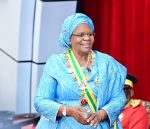While the gleaming new Namibian coins and upgraded banknotes unveiled this week capture the eye with their modern aesthetics and symbolic sector tributes, a deeper narrative lies embedded within the announcement – a story of profound national economic metamorphosis told through the remarkable journey of the Namibia Dollar itself.
The launch of the Bank of Namibia’s (BoN) upgraded currency series, marking its 35th anniversary, provided more than just details of new security features and redesigned coins. It offered a powerful retrospective, revealing a staggering statistic that transcends mere numismatics: the value of Namibian Dollar banknotes in circulation has ballooned from a modest N$200 million at its inception in 1993 to a colossal over N$5 billion as of June 30, 2025. This represents a more than 25-fold increase, a tangible measure of the nation’s economic scale, resilience, and institutional maturation over three tumultuous decades.
Governor Johannes !Gawaxab, in his poignant address during the launch ceremony, masterfully framed this growth not just as a numerical increase, but as the physical manifestation of Namibia’s arduous journey towards stability and self-determination. “Since the landmark introduction of the Namibia Dollar in 1993,” he declared, “our currency has not only expanded in scale… but a rise also matched by its sweeping transformation in form, function and sophistication.” His words painted a picture of a nation navigating global uncertainties and local challenges, consciously choosing a path of prudence and innovation. “Through uncertainty, we crafted stability. Through disruption, we chose innovation. Through doubt, we built trust.”
This exponential growth in currency circulation is far more than an accounting entry. Economists point to it as a critical indicator reflecting broader economic health. It signifies increased economic activity, a larger formal financial sector drawing in more participants, rising incomes facilitating greater cash holdings, and crucially, sustained public confidence in the national monetary system. Moving from N$200 million to N$5 billion speaks volumes about the expansion of Namibia’s GDP, the diversification of its economy beyond initial dependence, and the deepening integration of its population into the formal financial fabric.
President Dr. Netumbo Nandi-Ndaitwah, in her keynote speech, powerfully connected the currency’s evolution to the nation’s political and identity journey. Reflecting on the 1993 launch, she stated it “marked a defining moment in our journey towards self-determination and the assertion of our own distinct national identity.” The introduction of a national currency was, fundamentally, an act of sovereignty, replacing the South African Rand and asserting Namibia’s economic independence. The growth since then, culminating in this latest sophisticated upgrade, represents the consolidation of that sovereignty. “The launch of this new series is not just a matter of updating our money,” President Nandi-Ndaitwah emphasized, “it is a statement of confidence in our economy and a reaffirmation of our sovereignty.”
Governor !Gawaxab elevated the concept of currency beyond its utilitarian function. “Currency is more than a medium of exchange,” he asserted. “It is a declaration of confidence. A statement of sovereignty. A visible, tangible symbol of a people’s identity, history, and aspirations.” The Namibia Dollar, in its physical form and the trust it embodies, has become a mobile canvas upon which the nation’s story is etched. Its increasing volume and complexity mirror the nation’s own increasing complexity, ambition, and integration into the global economy. The transition from the first series to the now third-generation banknotes and second-generation coins reflects a parallel technological and security evolution, necessary to protect the value generated by that growing economy from counterfeiters and maintain public trust – the bedrock of any currency’s success.
The journey hasn’t been without its trials. The past 35 years encompassed global financial crises, commodity price volatility impacting key Namibian exports, regional economic pressures, and the recent global pandemic. The fact that the Namibia Dollar not only weathered these storms but saw its circulation multiply significantly is a testament to the resilience of the Namibian economy and the perceived stability managed by the Bank of Namibia. It underscores the central bank’s success in its core mandate of maintaining price stability – keeping inflation in check so that the N$5 billion today retains meaningful purchasing power, a stark contrast to hyperinflation scenarios seen elsewhere that rapidly erode currency value regardless of the volume in circulation.
The design choices of the new coins, while not the core of this growth story, subtly reinforce the narrative of a maturing, diversifying economy. Moving away from purely natural symbols (fauna and flora) to representing key economic sectors – Agriculture (Mahangu), Manufacturing (Renewable Energy), Tourism (Sossusvlei), Retail (Human Connection), and Mining (Diamonds) – reflects a conscious articulation of the engines driving that N$5 billion economy. These sectors, highlighted by the BoN for their GDP contributions, are the very foundations upon which the currency’s value and circulation rest.
Furthermore, the focus on inclusivity in the new designs – tactile features for the visually impaired on banknotes and distinct edges for coins – speaks to a broader societal maturation. It signifies an understanding that the benefits of economic growth and financial stability must be accessible to all citizens, ensuring everyone can confidently participate in the economy their collective efforts have helped build to this scale.
As Namibia prepares for the new series to enter circulation in August 2025, alongside the existing notes and coins for a smooth transition, the moment invites reflection. The upgraded security features and modern designs are forward-looking, aimed at safeguarding the future. Yet, their unveiling is irrevocably tied to the past – the three and a half decades of institutional building, prudent monetary policy, and collective national effort that transformed N$200 million into N$5 billion.
This growth story is a powerful counter-narrative to simplistic views of currency. It’s not just about the paper and metal in people’s pockets; it’s about the collective endeavour, the institutional credibility, and the national confidence those physical tokens represent. The new notes and coins are the next chapter, but the volume they join – that N$5 billion circulating testament – is the compelling story of how Namibia, through stability, innovation, and resilience, built an economy worthy of its sovereign currency. As Governor !Gawaxab concluded, looking ahead, “The next chapter is ours to write,” built firmly upon the substantial foundation laid by the remarkable growth chronicled in the journey of the Namibia Dollar itself.










